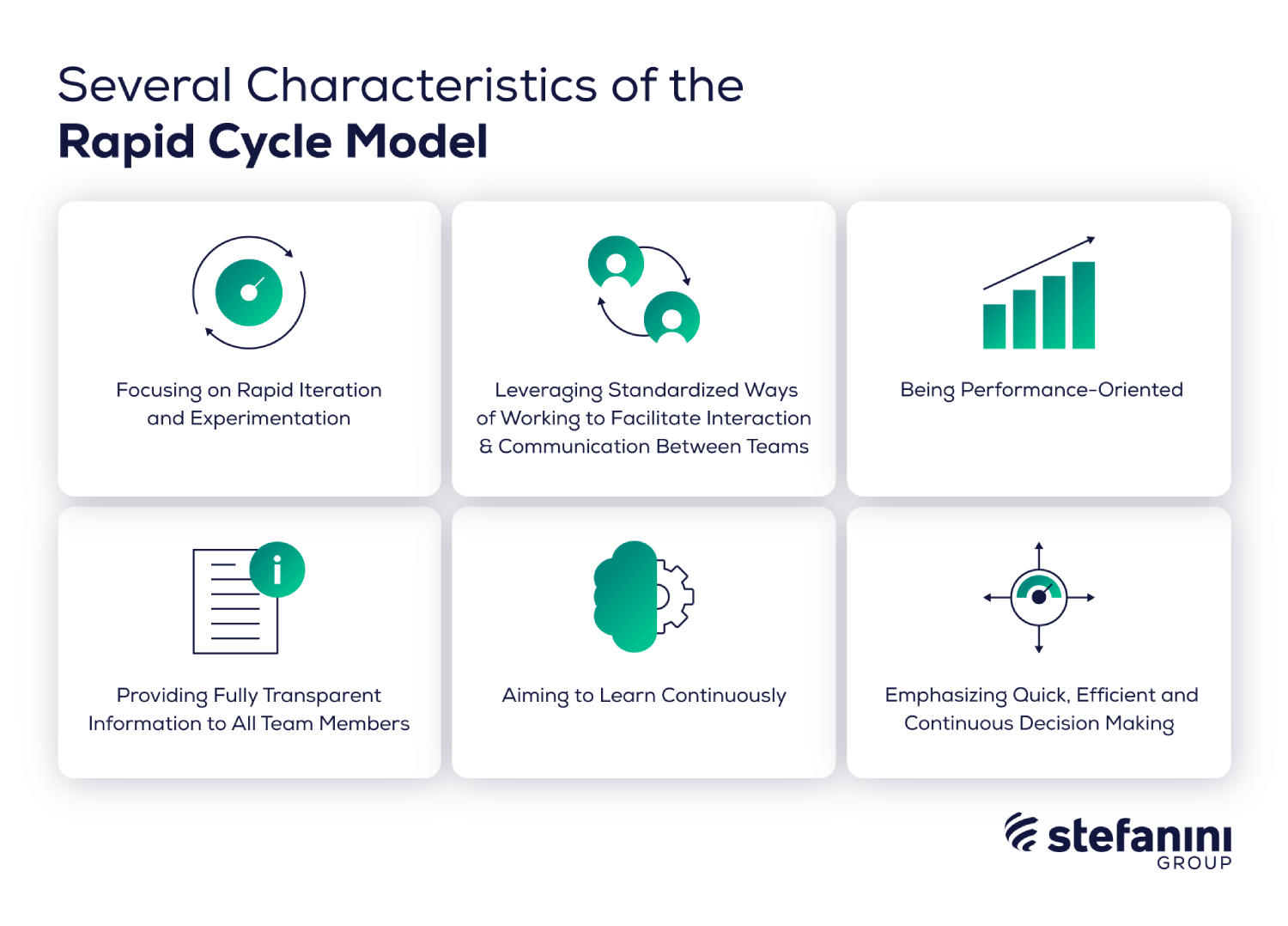Agile squads in the workplace are becoming increasingly common. How can agile squads help your business grow even more quickly? Read our Trends blog for the answer!
Agility in the workplace has become increasingly common. This shift is largely driven by the fact that small, multidisciplinary teams squads of agile organizations can respond swiftly and quickly to changing market opportunities and customer demands.
Agile squads, also known as autonomous teams, have a great deal of freedom and make their own decisions about how to achieve their goals. From pinning down product strategy to software development, agile organizations help businesses achieve goals faster and with more support from individual team members.
Want to learn more about agile squads? Check out Stefanini Solution Squads!
Strategies for Enabling Growth by Using Agile Teams
According to McKinsey, there are five best practices, also known as mindset shifts, which enable organizational agility. Any organization can potentially make any of the following shifts in all or part of their operations, as appropriate:
1) North Star embodied across the organization
To focus on and give coherence to their distributed value creation models, agile organizations set a shared purpose and vision – also known as the “North Star” – for the business that helps people feel both personally and emotionally invested. This North Star serves as a reference when employees decide where to work, customers choose where to buy, and partners decide where to engage. Agile organizations that combine a flexible, distributed approach to value creation with a deeply embedded North Star can quickly sense and seize opportunities. Across the organization, people individually and proactively watch for changes in customer preferences and the external environment and act upon them. They seek stakeholder feedback and input through methods such as hackathons, product reviews, and crowd sourcing. They also use tools like customer journey maps to identify new opportunities to serve customers better and gather customer insights through both formal and informal mechanisms like online forums, start-up incubators, and in-person events that help shape, pilot, launch, and iterate on new initiatives and business models. For example, within a business, there can be a tribe focusing on mobile. There is also the role of Tribe Leader who is responsible for providing the right environment for all the squads. These organizations also have the ability to allocate resources quickly and flexibly to where they are needed most. They regularly evaluate the progress of initiatives and decide whether the amount of time put into them was worth it or to shut them down by using standardized, fast resource- allocation processes to shift people, technology, and capital rapidly between initiatives, out of slowing business, and into areas of growth. These processes use clear metrics to allocate resources to initiatives for specified periods and are subject to regular review. Senior leaders bring coherence and provide clear, actionable, strategic guidance around priorities and the outcomes expected at the system and team levels, playing an integrated role across distributed systems. Further, they ensure everyone is focused on enabling people to work autonomously toward team outcomes, delivering tangible value to customers and all other stakeholders.
2) Network of empowered teams
Agile organizations maintain a stable top-level structure, but rely on a flexible, scalable network of development teams rather than a traditional hierarchy. Networks balance individual freedom with collective coordination, leading to a natural way to organize efforts. To build agile organizations, leaders need to understand human networks (social and business), how to build and design them, and how to nurture and sustain them. An agile organization is made up of a dense network of empowered teams that operate with high standards of accountability, alignment, expertise, collaboration, and transparency. The company must also have a stable ecosystem in place to allow teams to operate effectively:
a. Implement clear, flat structures that reflect and support the way in which the organization creates value, in which the number of teams within each group can be sized or scaled to meet changing needs.
b. Ensure clear, accountable roles like product owner so that people can interact across the organization and focus on getting work done instead of losing time and energy due to unclear or duplicated roles or the need to wait for manager approvals.
c. Make decisions as close to relevant teams as possible in highly-productive, limited-membership coordinating forums.
d. Evolve functions to become robust communities of knowledge and practice as professional “homes” for people, with responsibilities for attracting and developing talent, sharing knowledge and experience, and, as people rotate between different operating teams, providing stability and continuity over time.
e. In agile organizations, people work hands-on and day-to-day with customers, vendors, academics, government entities, and other partners in existing and complementary industries to co-create product development, services, and/or solutions and bring them to market.
f. Create and design open physical and virtual environments that empower people to do their jobs most effectively in the environment that is most helpful to them.
We now live in a virtual age – learn more about how Stefanini s bringing businesses virtual squads!
The basic building blocks of an agile organization are small fit-for-purpose performance cells that are more multidisciplinary, have greater autonomy and accountability, are more quickly assembled (and dissolved), and are more clearly focused on specific value-creating activities and performance outcomes. They can be made up of networks of individuals working separately or groups of individuals working on a shared task. According to Mckinsey, the three most commonly observed agile types of performance cells include:
· Cross-functional teams that deliver ‘products’ or projects, which make sure that the knowledge and skills to deliver desired outcomes reside within the team.
· Self-managing teams define the best way to reach goals, prioritize activities, and focus their effort, with different team members leading the group based on their ability rather than their position.
· Flow-to-the-work pools of individuals are assigned to different tasks full-time based on the priority of the need, enhancing efficiencies in the process.
3) Rapid decision and learning cycles
Agile organizations work in rapid cycles of thinking and doing that are closely related to their process of creativity and accomplishment. These cycles can be deployed as design thinking, lean operations, agile development, or other forms. This integration and continual rapid iteration of thinking, doing, and learning paves the way for the organization to innovate and operate in an agile way and can affect every level of working. There are several characteristics of the rapid cycle model:

- Focusing on rapid iteration and experimentation
- Leveraging standardized ways of working to facilitate interaction and communication between teams
- Being performance-oriented
- Providing fully transparent information to all team members
- Aiming to continuously learn
- Emphasizing quick, efficient, and continuous decision making
4) Dynamic model that ignites passion
By having an organizational culture that puts people at the center, more people are engaged and empowered throughout the organization, which enables them to create value quickly, collaboratively, and effectively. Organizations that have been successful in this venture have invested in leadership that empowers and develops its people, a strong community that supports and grows the culture, and the underlying people processes that foster the entrepreneurship and skill building needed for agility to occur. Through shared and servant leadership, leaders are catalysts that motivate people to act in team-oriented ways, and to become involved in making the strategic and organizational decisions that will affect them and their work. Further, agile organizations create a cohesive community with a common culture, reinforcing cultural norms through positive peer behavior and influence in a high-trust environment, rather than through rules, processes, or hierarchy. When it comes to employees, team members exhibit entrepreneurial drive, taking ownership of team goals, decisions, and performance. Agile organizations also allow and expect role mobility, where employees move regularly (both horizontally and vertically) between roles and teams, based on their personal-development goals.
5) Next-generation enabling technology
When rethinking organizational model, many organizations also need to rethink the technologies underlying and enabling their products and processes, as well as the technological practices to support speed and flexibility. Agile organizations must meet changing customer and competitive conditions by providing reworked product management, while digitizing or digitally-enabling traditional products and services. In that same token, operating processes will need to continually and quickly evolve. By integrating a range of next-generation technology development and delivery practices into the business, agile organizations will be able to support new technologies.
Have you embraced virtual agile squads at your business? Rewatch our webinar here!
Become More Agile with Stefanini
Today’s environment is pressuring organizations to become more agile. The new organizational forms emerging enable organizations to balance stability and dynamism while thriving in a period of unprecedented opportunity.
Stefanini Solution Squads work to combine agile methodologies and specific skills to create, develop, and test new ideas quickly. Curious as to how we can move your business forward by identifying goals to meet your KPIs? Learn more by contacting us today!



















